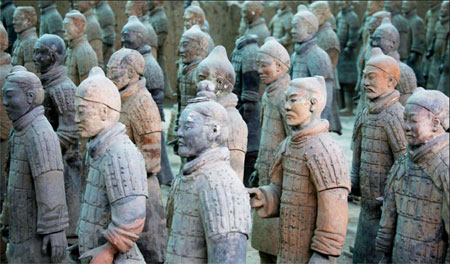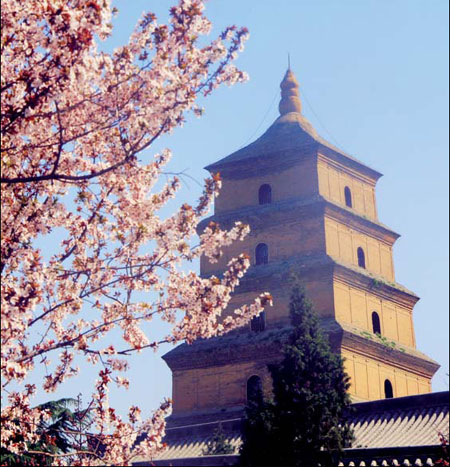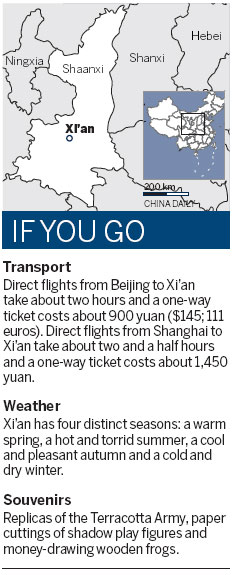Plenty of history
Updated: 2012-11-30 09:57
By Sun Yuanqing (China Daily)
|
|||||||||||


|
From top: Terracotta soldiers, each crafted with unique characteristics; the Big Goose Pagoda, built in the Tang Dynasty, probably the most iconic architecture in Xi'an; and the 12-meter-high, 14-kilometer-long city walls. Photos Provided to China Daily |

There is more to xi'an than its famed army of staTues. other historical sights that span 6,000 years will transport you BACK in time
As the saying goes, if you can see 500 years of Chinese history in Beijing, then you have four times that in Xi'an. Legend has it that with every step you take in the city, there could be a priceless treasure buried beneath your feet. And that's not an exaggeration if you know that the Terracotta Warriors, for which the city is most famous, were discovered by a local farmer digging a well.
Today Xi'an remains one of the major metropolises in the central part of China, with a new reputation as a base for electronics and aviation.
Like Beijing, Xi'an has an easy-to-navigate grid layout, a remnant of its role as a capital for an arguably 13 dynasties in imperial times, which left it with endless fascinating tales. On foot or bicycle, the city is a time machine that will take you back thousands of years.
1. Big Goose Pagoda
Probably the most famous piece of architecture in Xi'an, the Big Goose Pagoda offers stunning views of old Xi'an.
Built in the Tang Dynasty (AD 618-907), the heyday of Buddhism in China, the pagoda was dedicated to Xuanzang (AD 602-664), a monk who brought Buddhism from India to China. The pagoda served as an imperial place for prayer and a storage space for Buddhist scriptures.
With seven floors stretching 64.5 meters in one direction, it was built with a mixture of earth and glutinous rice.
Behind the pagoda sits the largest musical fountain in Asia, which plays at 12:30 pm and 8:30 pm every day.
2. Shaanxi History Museum
Among the top museums in China, Shaanxi History Museum is a paradise for those interested in history. Even those with little interest in the subject will find something of interest here among the smiling Tang Dynasty figures.
The museum consists of three main sections, displayed chronologically from primitive eras to the late Qing Dynasty (1644-1911). As the starting point of the Silk Road, an ancient trade route that stretched from China to the Middle East and Europe, Xi'an was a melting pot of different cultures and civilizations in ancient times. The Tang Dynasty, the climax of imperial China, features heavily in the museum.
Tickets are free but the number of visitors is limited to 4,000 daily. Arrive early and bring your passport or ID card as one ticket goes with one ID.
3. Terracotta Warriors
As the locals say, if you have never been to Xi'an, you have never been to China. And if you have never been to see the Terracotta Warriors, you have never been to Xi'an.
Part of the funerary art buried with Qin Shi Huang (259-210 BC), China's first emperor, and intended to protect him in the afterlife, the Terracotta Warriors were not discovered until 1974.
A hint of the army's massive scale can be seen in three pits, which represent just a fraction of the total, as most remain buried.
The figures, which included 8,000 soldiers, 130 chariots with 520 horses and 150 cavalry horses, were crafted to scale in clay, each with unique characteristics. Much of the collection was destroyed during wars in imperial times, and restoration work continues.
A shuttle bus from downtown Xi'an to the Terracotta Warrior site leaves every 10 minutes from near Xi'an Railway Station.
4. Banpo Museum
Banpo Museum houses remains and replicas of the settlements and people of the Neolithic Age. These people, considered the ancestors of the modern Chinese, lived more than 6,000 years ago.
Here you can see structured residences, complicated rituals and various remains. Either a knowledgeable tour guide or sufficient homework will be of great help in navigating the museum.
5. The city walls
The city walls snake around Xi'an, guarding the old city from the new.
Fifteen meters wide and 14 kilometers long, they are mostly preserved from the Ming Dynasty (1368-1644), when the walls were built for military purposes.
Choose a sunny day and rent a bicycle so you can cycle around while enjoying the spectacular skyline on both sides of the city. The trip takes about one hour and guarantees none of the traffic jams you would encounter in downtown Xi'an.
An electric sightseeing vehicle is available for 20 yuan ($3.2; 2.5 euros).
Eating
A production base for wheat, Xi'an is well-known for its noodles.
They come in all shapes, textures and flavors. Biangbiang noodles, with its outlandish name - in Chinese characters each syllable has 42 strokes - is one of the must-tries. These chewy noodles coupled with spicy beef and vegetables can be found in almost every corner of the city.
Take a stroll along Huiminjie, also known as the Muslim Quarter, and get a taste of the culture of the Hui ethnic group that lives there. Here you can get a bowl of pita bread soaked in lamb soup, which boasts juicy fresh lamb.
Save some room for the roujiamo, meat sandwich, a signature snack of Xi'an. It is a handy and tasty snack to eat on the go as you rush to your next destination.
Autumn may be the best time to visit Xi'an as it is the season for guavas and persimmons. The fruits grow here in abundance and are often cheaper and fresher than in other parts of the country.
China Daily
sunyuanqing@chinadaily.com.cn
(China Daily 11/30/2012 page23)
Today's Top News
Rescuers race against time for quake victims
Telecom workers restore links
Coal mine blast kills 18 in Jilin
Intl scholarship puts China on the map
More bird flu patients discharged
Gold loses sheen, but still a safe bet
US 'turns blind eye to human rights'
Telecom workers restore links
Hot Topics
Lunar probe , China growth forecasts, Emission rules get tougher, China seen through 'colored lens', International board,
Editor's Picks

|

|

|

|

|

|






